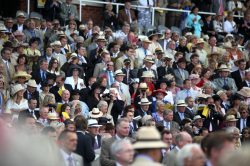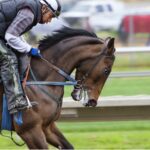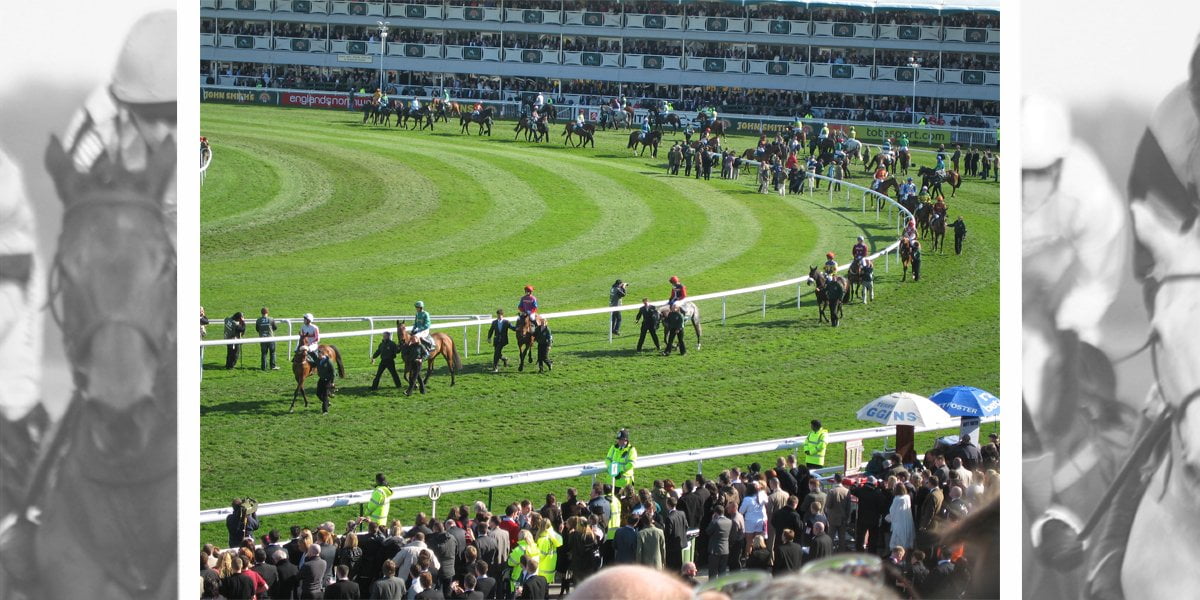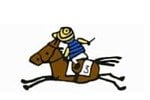[et_pb_section bb_built=”1″ admin_label=”section”][et_pb_row admin_label=”row”][et_pb_column type=”4_4″][et_pb_text admin_label=”Text” background_layout=”light” text_orientation=”left” use_border_color=”off” border_color=”#ffffff” border_style=”solid”]
History of Goodwood Racecourse: Racing was introduced to Goodwood by the third Duke of Richmond out of a sense of obligation to the officers of the Sussex militia, of which he was colonel.
For many years, the officers had held their annual races in nearby Petworth Park, courtesy of the Earl of Egremont, but when that capricious nobleman did not renew the invitation in 1801, the Duke of Richmond came to the rescue by laying out a course on that part of the Goodwood Estate known as the Harroway.
So pleased was the Duke with the popularity of that first two-day meeting that he organised a three-day one under Jockey Club Rules the following year. On the first day, he won with a horse called Cedar, but on the third day Cedar was beaten by Trumpator, owned by the Prince of Wales, later King George IV. To accommodate his more distinguished guests, the Duke had a small wooden stand erected.
The first Duke of Richmond, who purchased the Goodwood Estate in 1697, was an illegitimate son of Charles II and Louise de Keroualle, Duchess of Portsmouth.
His grandson, the founder of the Goodwood meeting, was a man of taste and considerable talent. He was one of the earliest patrons of the equine artist George Stubbs, who stayed at Goodwood for nine months in 1759, and, as Master-General of the Ordnance, he commissioned the first ordnance survey maps, still in use today.
Following the death of the third Duke in 1806, the title and estate were inherited by his nephew, an eminent soldier. A civilian by the time of Waterloo, he would have missed the battle had he obeyed the instructions of his friend the Duke of Wellington, who told him to go back to Brussels, but the fourth Duke hid in a bush and cheered the troops on!
Lack of funds (due to the third Duke’s prolific spending) prevented the fourth Duke from being at home for long periods. It was, however, during his time that the Goodwood Cup was first run in 1812 over a three-mile course.
 Two years later, at the suggestion of his son, the Earl of March, the date of the meeting was changed from May to its now long-traditional slot in late July. The move to July proved an immediate success and greatly enhanced the social status of the meeting. This was because it coincided neatly with the end of the London season and retained a relatively informal atmosphere, much appreciated by the aristocracy before they retired to their country estates for the remainder of the summer.
Two years later, at the suggestion of his son, the Earl of March, the date of the meeting was changed from May to its now long-traditional slot in late July. The move to July proved an immediate success and greatly enhanced the social status of the meeting. This was because it coincided neatly with the end of the London season and retained a relatively informal atmosphere, much appreciated by the aristocracy before they retired to their country estates for the remainder of the summer.
While the importance of the meeting increased, the Goodwood Cup did not immediately carry the prestige that it would in the middle of the century and was only staged spasmodically. It was not run in 1815 or between 1817 and 1824, while there was a walkover in 1826. No horse of any consequence won it until Priam, successful in the Derby of the previous year, in 1831, six years after the distance raced over was reduced to two miles and five furlongs.
The fourth Duke died in 1819 and was succeeded by his son, another notable soldier. Having been severely wounded by a musket ball at Orthez in the Peninsular War in 1814, the fifth Duke returned to Goodwood to devote himself to hunting.
When a heavy fall aggravated his old injuries so badly that he was obliged to give up following hounds, the Duke, who served a term as President of the MCC, devoted much of his time to racing. He did a great deal to improve the racecourse, including the building of a new grandstand for 3,000 people in 1830.
Also in that year, the Stables, completed to the designs of Sir William Chambers for the third Duke of Richmond in 1761, were filled with horses belonging to the fifth Duke of Richmond and Lord George Bentinck. A heavy gambler, who never felt himself constrained by the strict code of honour he sought to impose upon others, Lord George was overbearing far beyond the point of arrogance and a born organiser.
The outstanding member of the Jockey Club of that era, he was enabled, by his friendship with the Duke of Richmond, to implement many reforms at Goodwood that would later become common practice on other courses.
As well as railing off a number of enclosures, including one for cigar smokers, he reformed the method of starting by equipping the starter with a flag instead of simply having the official shout ‘go’. He also fined the Clerk of the Course if races started late and insisted that every horse had a number on the racecard corresponding to that displayed on the board indicating the runners.
Furthermore, he gave orders that the runners should parade in front of the stands. Bentinck also set aside an area in which they were to be saddled and another in which they were to be unsaddled.
In consequence, the Goodwood meeting was conducted far more efficiently than had ever been the case on any other course.
At the time when Lord George was bringing in these improvements, many of the most popular races of the Qatar Goodwood Festival were becoming entrenched in the programme.
The Molecomb Stakes was founded in 1833, while the six-furlong Stewards’ Cup was first run in 1840 when Epirus, trained by John Scott at Malton in Yorkshire, beat 21 rivals. The latter race is now the handicap highlight on the final day of the Qatar Goodwood Festival.
The Nassau Stakes also came into existence in 1840 and the Sussex Stakes was introduced in 1841 to coincide with the construction of a weighing room at the racecourse.
The Sussex Stakes started out as a race for two-year-olds but in 1878 the conditions changed it into a contest for three-year- olds over a mile and from that point never looked back.
 Goodwood’s popularity as a venue for horseracing began to grow rapidly, particularly after the Second World War during which there had been no racing on the course.
Goodwood’s popularity as a venue for horseracing began to grow rapidly, particularly after the Second World War during which there had been no racing on the course.
In 1953, 55,000 spectators gathered for the Tuesday of Glorious Goodwood (still at that time the only racing staged at Goodwood – an August meeting had been held from 1946 to 1948, but was then dropped from the programme), with no less than 21,000 on the slopes of Trundle Hill. That figure has not been surpassed since, but the demand for racing at this most scenic of courses led to the introduction of three additional fixtures in 1965, two in August and one in September.
The May meeting was started in 1968, while in 1970 Glorious Goodwood was extended to five days with the addition of the Saturday.
The racecourse has undergone some important changes. Until 1967, horses pulled up running up Trundle Hill, during which time the parade ring was positioned behind what is now the Charlton Stand.
In 1976, however, the parade ring was moved to the south side of the racecourse behind the March Stand. At the same time, the weighing room, which had previously been in the old Charlton building, was relocated to the north side of the parade ring. This involved moving the old road south of the racecourse.
The old Stand was demolished after the Festival meeting of 1979 and replaced by the present March Stand, designed by the architect Sir Philip Dowson, which won the annual Concrete Society Award. It was opened on 29th July, 1980, by Her Majesty The Queen who unveiled a bronze horse created by the famous sculptress, Dame Elizabeth Frink.
In June, 1985, an evening fixture was staged for the first time.
The next phase of redevelopment occurred in 1989 with the new Charlton Stand, followed in 1990 by the opening of the Sussex Stand at the Festival meeting by Peter (subsequently Sir Peter) O’Sullevan. The Sussex Stand won a commendation from the Royal Fine Arts Commission.
To coincide with this development and, with effect from the start of the 1990 season, the winning post was moved approximately 31 yards in the direction of the six-furlong start. As a result, starts and race distances had to be modified.
Thus the Goodwood Cup, traditionally run over two miles and five furlongs, was reduced to two and a half miles. Following the Jockey Club’s review of staying races, the distance of the Goodwood Cup was further reduced to two miles in 1991.
In 1989, a new race distance of one mile and one furlong was successfully introduced, starting at the same point as the one mile and two furlong start.
Prize money was steadily increased and more racing introduced, including additional evening meetings. Goodwood’s evening fixtures, now on Fridays, remain enormously popular.
The staging of Goodwood’s first Sunday fixture, following the legalisation of Sunday betting, happened on 27th August 1995 – the Sunday of the August Bank Holiday – while Goodwood held the inaugural running of the Shergar Cup, now run at Ascot, in May, 1999. Goodwood currently has three Sunday fixtures.
The exciting paddock development, innovatively designed by Sir Michael Hopkins, opened in 2001. It comprised a new Members’ entrance, Double Trigger Restaurant, three elliptical pavilions housing bars and restaurants and a 5,000 viewing capacity amphitheatre style parade ring.
 The racecourse celebrated its 200th anniversary in 2002 and the occasion was marked by the publication of the Glorious Goodwood book and video. In 2003, Goodwood extended its racing calendar by introducing an extra day’s racing in October. This increased the season from 20 to 21 days and, for the first time since the early 1990s, saw autumn racing return.
The racecourse celebrated its 200th anniversary in 2002 and the occasion was marked by the publication of the Glorious Goodwood book and video. In 2003, Goodwood extended its racing calendar by introducing an extra day’s racing in October. This increased the season from 20 to 21 days and, for the first time since the early 1990s, saw autumn racing return.
In 2007, another October day was added bringing the total to 22 days, while 2009 has a record 23 racedays, thanks to a new fixture on the second May Bank Holiday Monday.
At the end of 2014, Goodwood Racecourse announced the biggest sponsorship deal ever in British racing involving a 10-year deal with Qatar.
The partnership, which commenced in 2015, resulted in over £2 million extra being invested into prize money for eight key races during the Qatar Goodwood Festival as well as a commitment to increase this year-on-year.
Total prize money on offer for the week now totals £4.975 million, with Qatar again demonstrating passion and support for British racing.
A modern-day record of 103,457 racegoers attended the five-day Qatar Goodwood Festival in 2015.
The Group One Qatar Sussex Stakes has a total prize fund of £1 million, cementing its position as one of the most valuable mile races in the world.
The Group One Qatar Nassau Stakes, the feature race on the Saturday of the Qatar Goodwood Festival is worth £600,000, making it the most significant mid-summer race for fillies and mares, as well as the richest European race of its kind.
Each Group Two feature race, the Qatar Lennox Stakes (Tuesday), the Qatar Goodwood Cup (Thursday) and the Qatar King George Stakes (Friday) is worth £300,000, attracting some of the best horses at their respective distances.
Other races that benefitted from increased prize money last year are the two Group Two races for two-year-olds, the Qatar Vintage Stakes and the Qatar Richmond Stakes, each of which is worth £200,000, supporting their status as the proving grounds for future champions.
The Qatar Stewards’ Cup is the headline handicap of the week with prize money totalling £250,000 and, as part of this uplift, the consolation race rose to £75,000.
There is a key race for Arabian horses staged at the Qatar Goodwood Festival, with the Qatar International Stakes, with prize money of £400,000, being the first leg of the Arabian Triple Crown. The second leg will take place on Arc day in France and the final one at Doha in Qatar.
The present Duke of Richmond (born 1929), who trained as a chartered accountant, and his son the Earl of March and Kinrara ensure that the Goodwood Estate as a whole is enjoyed and utilised to its fullest potential, but it is the racecourse that remains the jewel of their family’s inheritance.
The 10th Duke of Richmond, Lennox, Gordon and Aubigny developed and strengthened the Estate, with particular focus on the racecourse.
Lord March (born 1955), took over the chairmanship of the Goodwood Group of Companies in 1994. He founded both the Festival of Speed (1993) and the Goodwood Revival Meeting (1998).
Before assuming the management of the Estate, he was a successful advertising photographer in London and continues his photography career as Charles March. He married the Hon. Janet Astor, daughter of the third Viscount Astor, in 1991 and they live in Goodwood House with their children.
King Charles II established the headquarters of English racing upon the stark magnificence of Newmarket Heath. By way of complete contrast, his descendants, the Dukes of Richmond, created the most beautiful racecourse in the country amidst the tranquillity of the vividly undulating Sussex countryside overlooking the sparkling waters of Chichester Harbour and the sea.
THE GOODWOOD PORTFOLIO
Goodwood is more than just a racecourse. It is a country estate, covering 12,000 acres, quite different from any other. Its unique ambience and air of understated glamour have drawn people to it throughout three centuries of ownership by the Dukes of Richmond. It is made up of many varied aspects.
There is the House, which was refurbished between 1966 and 1971 and again between 1994 and 1998 and is now restored to its former Regency glory; an historic motor circuit which has once again resounded to the roar of historic racing cars since 1998; a hotel and country club, aerodrome and golf club. Each of the sporting activities on the Goodwood Estate reflects the particular interest of one of the Dukes of Richmond.
 Goodwood House hosts parties, both private and corporate, as well as weddings for couples who want to celebrate their marriage in magnificent surroundings. The racecourse boasts private boxes, restaurants and bars to suit all tastes. Racegoers gather to watch top-class jockeys battle it out on this most beautiful of racecourses set high on the Sussex Downs.
Goodwood House hosts parties, both private and corporate, as well as weddings for couples who want to celebrate their marriage in magnificent surroundings. The racecourse boasts private boxes, restaurants and bars to suit all tastes. Racegoers gather to watch top-class jockeys battle it out on this most beautiful of racecourses set high on the Sussex Downs.
The annual Festival of Speed has established itself as the most exclusive garden party fixture of the season where motor racing fans mingle with spectacular cars and their drivers in the parkland surrounding Goodwood House.
The ninth Duke of Richmond did not share his forbears’ great passion for the turf, but loved racing – in the form of motor cars. Adjacent to the Estate was the RAF Airfield at Tangmere and it eventually dawned on him that its annexe, Westhampnett Airfield, part of the Goodwood Estate, would make a suitable motor circuit. The first meeting took place in 1948 and, until its closure in 1966, the Goodwood Motor Circuit was Britain’s leading racing venue.
Re-opened in 1998, the circuit stages an historic race meeting, the Goodwood Revival, each September, which lovingly recreates the glamour and romance of motor racing in the 1950s and 1960s.
The Festival of Speed is the other major motor sport event at Goodwood. It is the world’s biggest and most diverse celebration of the history of motor sport and car culture. The Festival of Speed is the only occasion to see the greatest competition cars and star drivers from all eras in action: everything from 19th century steam carriages to current Formula One; fabulous racing motorcycles; classic rally cars to 3000bhp dragsters; plus motor sport legends like Moss, Surtees, Fittipaldi and Andretti rubbing shoulders with today’s hottest properties such as Lewis Hamilton, Jenson Button, Fernando Alonso and Petter Solberg.
The Flying School continues to attract people from all walks of life keen to gain the freedom of their private pilot’s licence or simply to soar above the stunning Sussex countryside.
Just across the park from Goodwood House, the refurbished Goodwood Hotel (formerly ‘The Richmond Arms’) offers everything you might expect from a world-renowned hotel.
The old Goodwood Golf Course, stretching up the Downs to the Racecourse, was superbly renovated in 2004 and is one of the two 18-hole courses on the Estate. Golf At Goodwood, a brand new vision for the sport, was launched in 2006 and is about paying for the golf that people want to play, when they want to play it. Members have access to the Downs Course, already rated in Golf World’s Top 100 courses in Great Britain and Ireland, and the Park Course. Instead of paying a high joining fee and annual subscription, the credit system has been designed to allow members to play as much or as little golf as they would like. The Park Course is also open to casual green fee visitors.
All of the Estate’s activities can be viewed at www.goodwood.co.uk
[/et_pb_text][/et_pb_column][/et_pb_row][/et_pb_section]

RACHEL GROOM is Eclipse Magazine’s Photography Editor. Known for her ‘street’ photography she is also an in-house documenter of racing activities at a training yard in Epsom and loves a big day out at the races. You can see more of her work at www.rachelgroom.com






